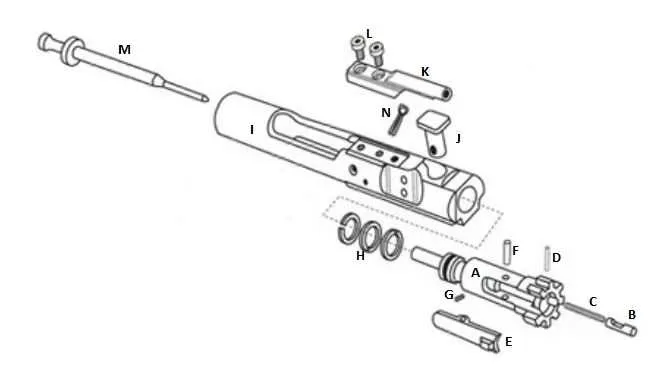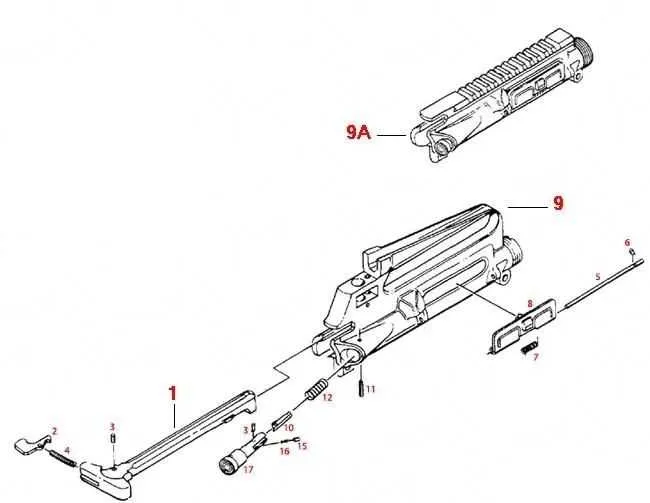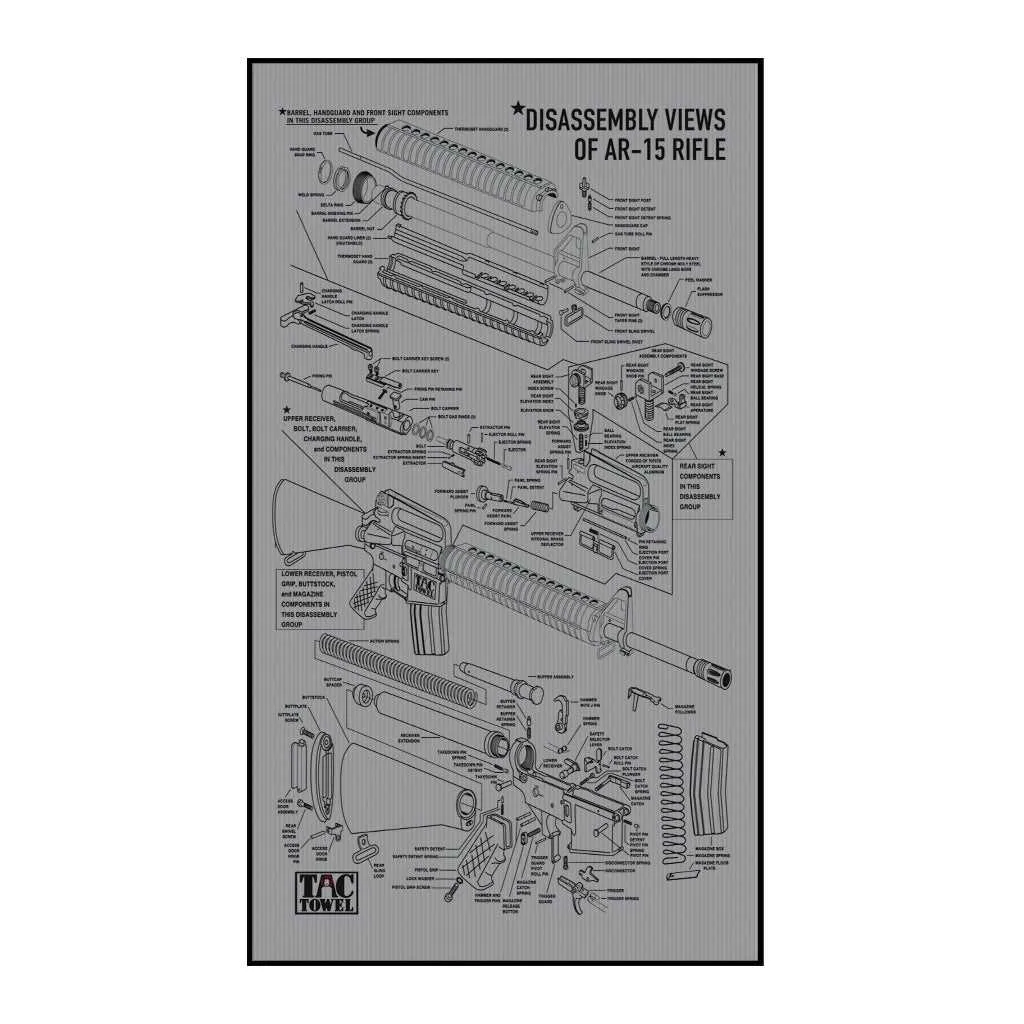
The AR-15 rifle is made up of various intricate elements that contribute to its overall functionality. When assembling or disassembling the firearm, having a clear representation of its individual components is critical. This allows for a better understanding of how each part interacts with the others, ensuring proper maintenance and operation. Whether you’re replacing a specific element or just familiarizing yourself with the design, a detailed illustration of its construction is essential.
Key sections of the rifle, such as the upper receiver, bolt carrier group, and lower receiver, are crucial to its performance. Knowing where each piece fits and its role in the firing sequence can significantly improve your handling and troubleshooting skills. To avoid confusion during assembly, it’s vital to focus on the distinct assembly groups, as this simplifies the understanding of more complex mechanisms.
When handling such firearms, precision in reassembly is paramount. Even minor misalignments can result in failure to function properly. It’s not just about knowing the parts, but also how they fit together to form a reliable and safe system. Therefore, investing time in mastering the visual layout of these elements will save valuable time and effort during repairs or upgrades.
AR-15 Component Breakdown
To maintain or assemble an AR-15, understanding each individual component is essential. Here’s a breakdown of the key elements:
- Upper Receiver: Houses the bolt carrier group, charging handle, and barrel. Ensure proper alignment and secure mounting.
- Lower Receiver: Contains the trigger assembly, magazine well, and fire control group. It is the serialized part of the firearm.
- Barrel: Critical for accuracy and ballistic performance. Choose length and twist rate based on intended use (e.g., 16″ barrel for general use).
- Bolt Carrier Group (BCG): Central to the cycling of the rifle. Regular cleaning and lubrication are key to reliable function.
- Buffer Assembly: Works in tandem with the recoil spring to manage the cycling action. Proper weight of the buffer is crucial for cycling reliability.
- Gas System: Includes gas block, tube, and key. The length of the gas system affects cycling speed and recoil.
- Trigger Mechanism: Available in standard or enhanced varieties. Opt for a smooth and predictable pull for optimal performance.
- Handguard: Protects your hands from barrel heat and allows for mounting accessories. Choose based on rail type (Picatinny or M-LOK).
- Stock: Adjustable for comfort and fit. Consider a collapsible or fixed option depending on usage needs.
Proper assembly requires attention to detail, especially with regard to the alignment of the gas tube and ensuring no interference with the trigger components. Check for proper torque specs on all screws and bolts to avoid malfunctions.
For reliability, ensure each part is compatible with the others, particularly the BCG, buffer system, and gas system. Frequent cleaning and maintenance will extend the life of these components and prevent malfunctions during operation.
How to Read and Interpret the AR-15 Parts Diagram
To effectively understand the layout of an AR-15, focus on the labels and number references in the schematic. Each component is assigned a specific reference number, making it easier to identify individual sections and subassemblies. Begin by identifying the upper and lower receivers, as these house the key parts that interact during operation.
Start with the Bolt Carrier Group (BCG). This critical assembly is shown with its key components such as the firing pin, extractor, and gas key. Pay attention to how each part fits within the BCG, as improper alignment can affect firearm reliability.
Next, observe the trigger mechanism. The trigger, hammer, and disconnector are shown in detail, highlighting how they engage during firing. Be sure to examine the specific movement paths and interaction points, as these parts must align precisely for proper function.
Focus on the gas system, which includes the gas block and tube. The gas block regulates pressure, directing gas into the system. Understand its positioning relative to the barrel, as any misalignment can lead to malfunction.
Look at the buffer system, particularly the buffer tube and spring. The weight and tension of the buffer spring directly impact cycling speed and recoil. A mismatch between the buffer and the spring can lead to feeding or ejection issues.
Lastly, identify the role of the safety mechanism, including the selector switch and its positioning. The diagram often shows the selector switch in multiple positions, allowing you to quickly understand the operational state of the firearm.
By focusing on each key section individually and following the numbered references, you can quickly develop a strong understanding of how each part fits together and functions within the AR-15 system.
Key Components and Their Functions in the AR-15

The upper receiver houses the bolt carrier group (BCG), which is essential for chambering and firing rounds. It plays a central role in cycling the weapon, as it moves the bolt forward, locks it, and ejects spent casings after each shot. The gas key on the BCG directs gas into the system, which drives the piston or impinges on the carrier for cycling.
The barrel is another critical element. Its length and twist rate determine accuracy and projectile stability. The muzzle end often includes a flash suppressor or compensator, which reduces visible muzzle flash and recoil. The barrel material, typically chrome-lined or stainless steel, affects the durability and precision of the rifle.
The lower receiver, where the trigger assembly and magazine well are located, holds the fire control components and allows for proper feeding from the magazine. The buffer system, consisting of the buffer tube, spring, and buffer weight, controls the recoil and ensures smooth cycling of the weapon by absorbing the force generated during firing.
The stock, which can be adjustable, offers stabilization and comfort for the shooter. It also houses the buffer tube and allows the user to modify the rifle’s overall length for personal preference or tactical requirements.
The handguard, positioned around the barrel, provides a grip surface and protects the shooter’s hands from the heat generated during firing. Some models include rail systems for attaching accessories like lights, lasers, and foregrips.
The gas block regulates gas flow from the barrel to the piston or gas tube. By controlling the gas pressure, it ensures the rifle operates efficiently, preventing malfunction while offering adjustable settings for different ammunition types.
Common Issues in AR-15 Components and How to Troubleshoot Them

If your AR-15 is experiencing issues, the problem is often linked to specific components. Here’s how to troubleshoot common malfunctions.
1. Failing to Fire
The most common reason for this issue is a malfunction in the firing mechanism. Check the hammer, trigger, and disconnector for wear. Ensure the safety selector is in the correct position. A weak or damaged firing pin spring can also prevent ignition; replacing it may resolve the issue.
2. Light Strikes
A weak or worn-out hammer spring is typically the cause of light strikes. Test the spring’s tension and replace it if necessary. Additionally, inspect the firing pin for any damage or obstructions that may impair its function.
3. Failure to Extract
A common problem here is a dirty or corroded extractor. Clean the extractor, and check the extractor spring for tension. If the spring is weak, replace it with a new one to ensure proper extraction.
4. Failure to Feed
Issues with feeding usually come from a damaged or weak magazine. Inspect the magazine lips and spring for any bends or excessive wear. Clean the feed ramps in the upper receiver to remove any debris. If the magazine spring is worn, replace it to restore functionality.
5. Double Feeds
A double feed can occur when the bolt fails to properly strip a round from the magazine. This may be caused by an overly tight or worn-out magazine spring. Check the bolt carrier group for proper alignment and ensure it’s clean. A worn-out gas system can also contribute, so verify the gas key is tight and the gas rings are intact.
6. Stovepiping
Stovepiping occurs when a spent casing fails to eject fully. This issue is often related to an underpowered or misdirected gas system. Ensure the gas block is aligned correctly and the gas tube is unobstructed. Inspect the ejector and extractor for wear, and replace as needed.
7. Inconsistent Ejection
If your rifle ejects shells erratically, check the ejector spring for proper tension. Inconsistent ejection can also be caused by a malfunctioning buffer system. Ensure the buffer spring is not overly compressed or damaged.